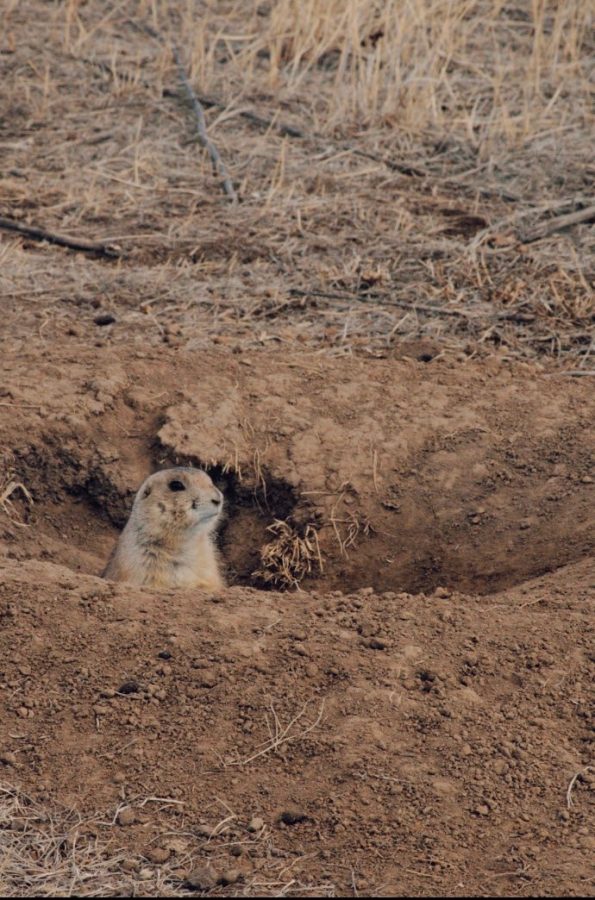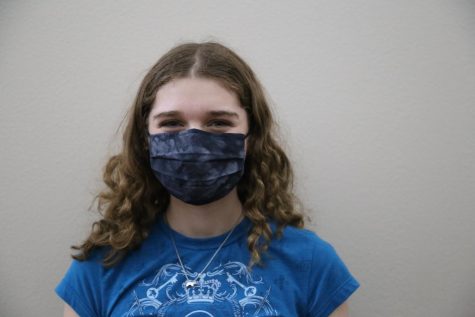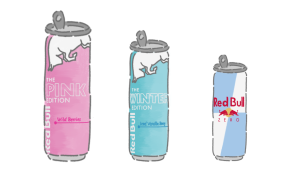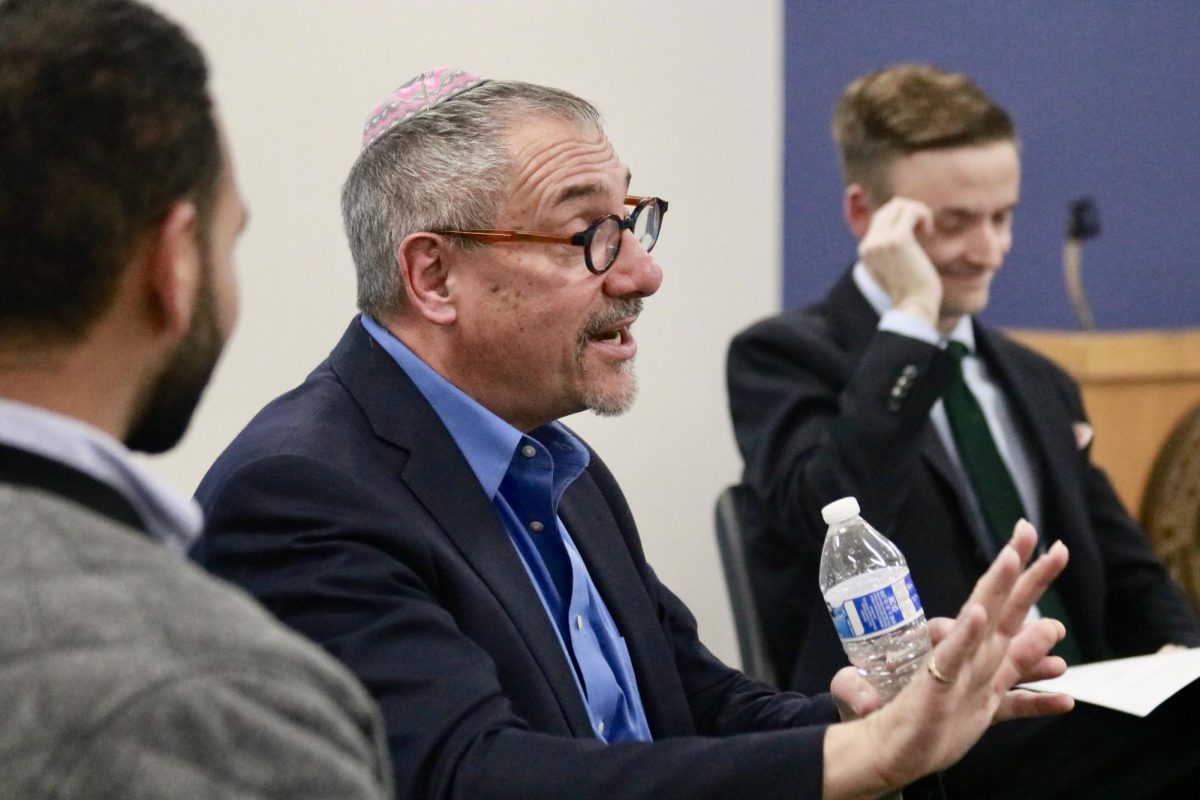Burrowing into the future of Denver’s heat and energy
Just another day on the plains: A prairie dog sits in its new burrow talking to its friends from afar. “They have a very complex social system. They’re very loving, very cool,” relocation specialist Sandy Nervig said.
March 3, 2021
If you’re short on time:
-Xcel Energy is conducting a natural gas project in the Cherry Creek Reservoir.
-Xcel began planning in the summer of 2020. The project is subject to change, but as of now, should be completed by fall 2021.
-This project was required by certain federal regulations which were recently updated.
-Prairie dogs that live in the Cherry Creek Reservoir area will be temporarily and passively removed from their habitats until the project is completed.
-Occasional public disturbances will take place within the duration of the project.
Home. A word that has recently become a distant memory and unfamiliar for most prairie dogs in the Cherry Creek Reservoir area as they are forced to say goodbye to a place they grew up in.
Xcel Energy, a company that is responsible for powering and heating our houses, supermarkets, and buildings, is conducting a project to extract natural gas from the Cherry Creek Reservoir area. To do so, approximately 5.5 miles of steel pipeline, plus additional valves will replace the functionality of an old pipeline installed in the 1950s.
This project will secure the gas required to disperse throughout the entirety of the southeastern Denver metropolitan area.
Planning for this project started in the summer of 2020 and will continue being constructed through the fall of 2021. For this duration of time, the prairie dogs in the area will be temporarily and passively separated from their burrows.
Reason for the project
Due to federal regulations being updated, Xcel Energy was required to carry out this project.
In the early 1950s, Xcel purchased the land where the original pipeline was built. At that point in time, federal requirements did not have specific levels of documentation. Now in 2021, federal regulations have become stricter and include more detailed requirements about the pipeline, including details about the amount of natural gas the pipeline must be able to hold and maintain.
Since the earlier pipeline didn’t meet these specifications, Xcel had to take steps to meet the new standards and keep things safe for citizens.
In the years following 1950, people built on top of and to the side of the pipeline. All sorts of buildings were wrongfully installed. Since Xcel could not cut through buildings and tennis courts built near the pipeline, Xcel determined that their best option was to build a new pipeline and lower the production of the original one.
To comply with budding construction in the surrounding neighborhoods and promising areas where people would want to build on the pipeline (which would force Xcel to relocate the pipeline in later years); Xcel decided the best place to construct the new one is in the Cherry Creek Reservoir.
Effect on residents
For the duration of the project, occasional public disturbances will take place. These disturbances include:
-elevated levels of noise
-tail and sidewalk partial and complete closures
-measures to control traffic (ex: flaggers, detours)
-temporary changes of access to site
Besides the occasional disturbances, Xcel is working very hard to safely provide natural gas to our homes and businesses.
“Safety is always our number one job,” Xcel’s area manager of community and local government affairs Tom Henley said. “And it [safety and allowing residents to have heat] is a priority for us.”
Effect on the Prairie Dogs
To comply with the project’s construction area, around 4 to 6 prairie dog colonies, which house hundreds of prairie dogs, are being moved into adjacent land.
Xcel knew that prairie dogs were in the area, but had decided that moving the prairie dog colonies was still the best and safest option they had.
“We can’t win as a company,” Henley said. “But we always choose the path that is going to be least impactful. In this case, being able to passively relocate the prairie dogs is the best thing for everyone.”
Unfortunately, prairie dogs have been fighting a losing battle for many years. Compared to earlier times when prairie dogs were thriving, the population of prairie dogs in this area is now less than one percent of the population from prior years.
Several local groups have been formed to help protect local prairie dogs, but the prairie dogs are still constantly subjected to being poisoned and killed.
Prairie Protection Colorado, a local non profit group, has been involved since the planning period of Xcel’s project, in an effort to try to protect the prairie dogs of this area.
“I love this colony,” Prairie Protection Colorado Executive Director Deanna Meyer said. “And I’m going to make sure they’re safe.”
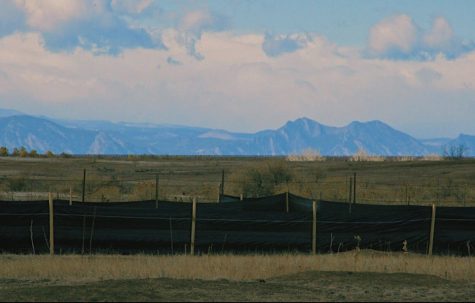
Because of these efforts, this project was designed to “minimize impacts to prairie dogs while complying with applicable regulations and acknowledging public concerns,” states Xcel Energy in the project plan.
Due to Prairie Protection Colorado’s consistent efforts, Xcel hired a humane extractor to temporarily relocate the prairie dogs, instead of removal of the prairie dogs through other means. Xcel hired Sandy Nervig, a specialist in humane relocation.
Sandy Nervig and the team of experts leading this non-lethal extraction plan have worked hard to make this a humane and safe process. Prairie dogs generally adapt well to changes and are able to adjust to new environments when this is used. This process is commonly used to temporarily relocate prairie dogs safely.
“I’m an all or nothing person,” Nervig said. “If I’m going to start it [the passive relocation], I want to get every last prairie dog, which the majority of the time I do.”
Here’s how it works:
There are two stages. After three months of thorough work, stage one was complete. The second stage will occur when the weather is warmer (so that conditions are optimally safe for the prairie dogs to relocate).
Stage one: first, a black fence will be installed around the work area, with a one-way exit to show the prairie dogs a direction to move toward. Then, a poultry wire one-way-door will be installed on top of the burrows to allow for an exit but not re-entry. Once all prairie dogs have left, the burrows will be safely collapsed.
After the collapse of the prairie dogs’ burrows, a fence will be placed to conceal the solitary side that allowed for prairie dogs to evacuate from their homes.
Stage two: this process will be repeated, and the prairie dogs will be pushed back even further.
“My job right now is to do everything I can to help save them and save the ones that are left,” Prairie Dog specialist Sandy Nervig said.

